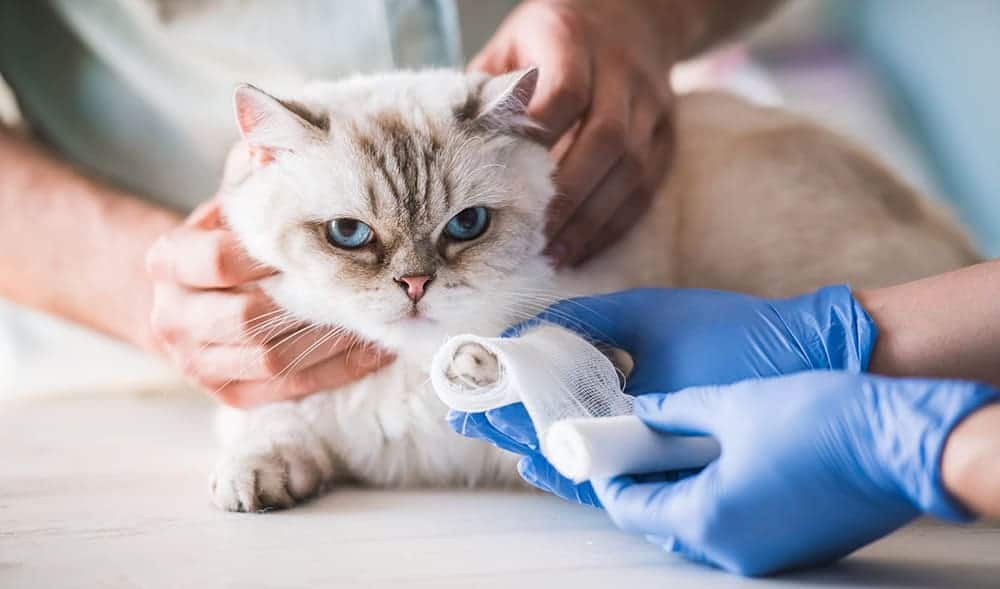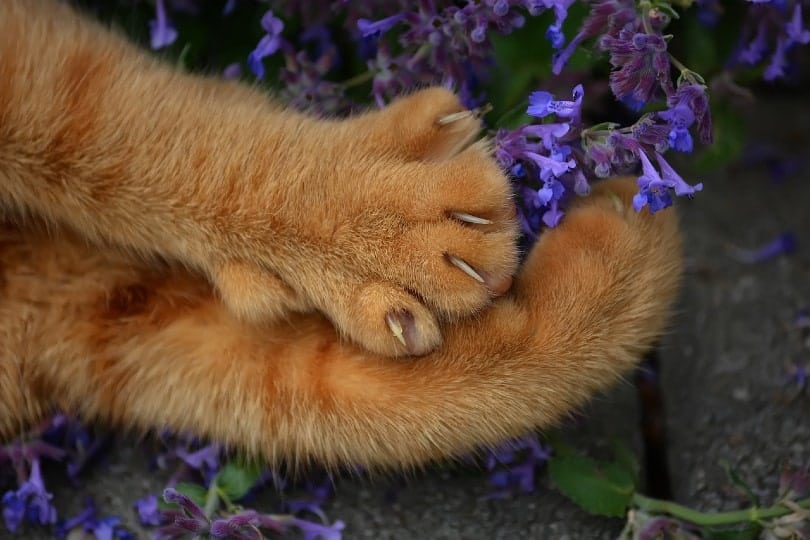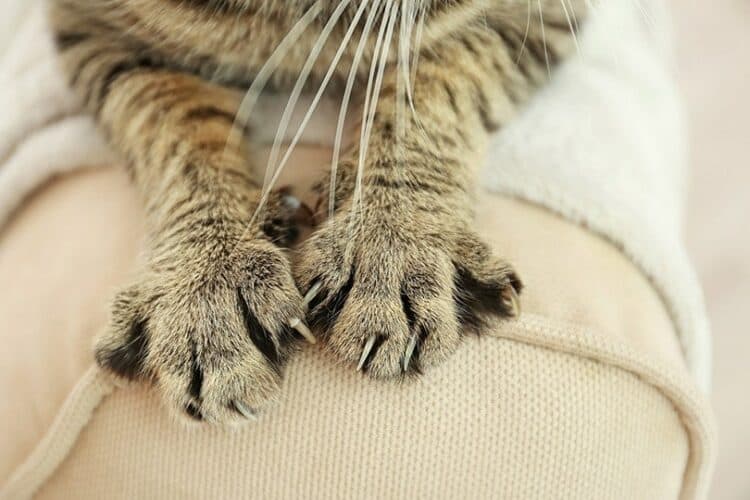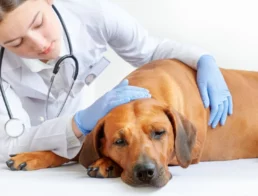Cats are remarkably clean creatures. So, cat parents rarely think to intervene and help their cats out with regular maintenance. That doesn’t mean our cats don’t need our help, though! While many people assume that their cats will clean up after themselves, they don’t think about how some cats may need the extra help. Older cats often lose mobility and flexibility that would allow them to properly maintain their own coat.
Cleaning your cat’s paws doesn’t usually come to the forefront of any cat parent’s idea of owning a cat but occasionally doing so can be helpful to your cat and help you maintain a peaceful household. Cats need healthy, clean feet to perform the tasks in their daily lives like scratching, exploring, and their ever-impressive acrobatic landings.
Why You Should Clean Your Cat’s Paws
At a minimum, you should check your cat’s paws regularly for any debris or signs that they may be ill. Issues like an infected paw pad or some debris stuck in the foot can be remedied before they present a real issue if you clean your cat’s paws regularly and cat them early.
Not cleaning your cat’s paws occasionally can result in pain, infection, and even amputation in severe cases. Cats are naturally explorative and curious. Anywhere they can get into usually means they’ll get all kinds of junk in their paw pads.
Cleaning your cat’s paws can also help them reduce the amount of debris that they track around the home, increasing the amount of cleaning you have to do every day! You can reduce how much you have to clean your floors by cleaning your cat’s feet and preventing them from tracking dirt all over your home.
Long-haired cats may also have hair that grows between their paw pads which can track dirt and debris around your home as your cat drags the fur around like a duster that doesn’t get emptied into the trash. It can also irritate your cat and make it uncomfortable for them to walk around.

How to Clean Your Cat’s Paws in 3 Simple Steps
1. Check Your Cat’s Paws for Injury
Start by looking over the paw for any injuries like splinters or signs that your cat is developing pillow foot. Pillow foot is an uncommon condition that can affect cats’ paw pads. It’s not necessarily painful. So, your cat may not notice that they’ve started to develop it.
If your cat is developing pillow foot, the paw pads will appear mushy, purplish, and ulcerated. If your cat is showing any signs of pillow foot, contact your veterinarian immediately and have your cat seen as soon as possible.
2. Clear Debris and Treat Injuries
Wipe your cat’s paws down with a damp cloth to remove any debris from the foot. Be sure to get in between the toes and beside the paw pads to ensure that the paws are sparkling clean. Once your cat’s paws are clean it’s time to treat the injuries your cat may have incurred through their inquisitive nature.
Remove any splinters and sterilize any cuts or minor injuries to your cat’s paws to reduce the risk of infection and long-term damage.

3. Clip Nails and Trim Foot Fur
You only need to clip your cat’s nails and trim their foot fur when they start to look long. Your cat will only need a nail and fur trim about once a month, usually.
Clipping your cat’s nails is pretty easy and should be your first order of business since cats tend to dislike having their nails trimmed, even if it’s healthy for them. Gently put pressure on the toes and center paw pad to encourage your cat to release their claws.
Once the claws are visible, use a nail trimmer to clip the paw just below the milky white part of the claw. The milky white part contains a small vein called the “quick.” If you accidentally clip the quick, your cat will start to bleed, so avoid the quick.
To trim the fur around the feet, you can use safety scissors or a pet fur buzzer. Cut the fur down until it’s level with the paw pads to prevent the fur from tucking under the pads when your cat walks. Once the fur is trimmed down, it should stop hindering your cat’s movement and tracking dirt all over your home.
Other Tips to Care for Your Cat’s Paws
It’s not just during the cleaning process that you can make choices that improve your cat’s quality of life and paw health. There are lots of things you can do to make cleaning your cat’s paws easier and less time-consuming.
Do Not Declaw Your Cat
Declawing your cat can have devastating effects on your cat’s quality of life. It’s very dangerous and vets everywhere recommend that cats not be declawed.
While many people believe that declawing is a simple procedure where the claws are pulled out, declawing is actually an invasive procedure that amputates the last bone in each of your cat’s toes. It’s not only an unnecessary surgery, but it also presents opportunities for lifelong complications such as pain, tissue death and infection.
Declawing also affects how your cat walks since their feet will be shaped differently afterward. Your cat may experience pain while walking or using the litter box, which can result in reduced mobility and inappropriate elimination. All in all? It’s just not worth the potential risks.

Provide Ample Scratchers for Your Cat
Cats’ love for scratching is no closely guarded secret. Scratching is a vital function of life for cats that acts as a way to exercise, mark territory, and sharpen their claws. When a cat scratches something, they shed away the dull outer coating of their coat, revealing the sharpened claw beneath the shell.
If you want to avoid your cat scratching at your furniture, offer your cat more appealing scratching surfaces like corrugated cardboard and sisal rope. These materials are perfect for sharpening your cat’s claws and present a fun experience for your cat that will have them ignoring your furniture in no time.
Watch for Signs of Infection or Pain Like Limping
Keeping an eye on your cat to ensure that they’re not limping or in pain can help you stay on top of your cat’s paw health and intervene before your cat needs veterinary attention. If your cat is limping, favoring one paw, or otherwise walking with an unusual gait, check their feet to see if they’ve got a splinter or other infection brewing that might be causing them pain.
Keeping an eye on your cat’s overall health can help you get ahead of any health issues that might arise for your cat. Early intervention is key with most health problems, and benign issues can spiral out of control if not dealt with in a timely fashion.
Conclusion
Cats are proud creatures that will rarely ask for help or show that they’re struggling with something. Still, as their owners, we should make an effort to help them even if they don’t ask! Cleaning your cat’s paws is a great way to improve their quality of life and comfort.
Featured Image Credit: Africa Studio, Shutterstock














